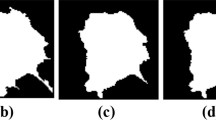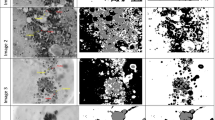Abstract
Fuzzy clustering has been gaining prominence in medical image segmentation but challenges still exist. This paper proposes a novel Type-II Intuitionistic Fuzzy C Means clustering algorithm by introducing a new membership degree called Intuitionistic Type-II membership. Intuitionistic Type-II membership combines Type-II membership with hesitation degree. Using Intuitionistic Type-II membership, the proposed algorithm shows following advantages: (1) defining clusters clearly, (2) robustness to noise and outliers, and (3) improving desired position of centroids. These advantages make Type-II Intuitionistic Fuzzy C Means clustering algorithm a preferred choice for mammogram segmentation. On some mammograms from Mammographic Image Analysis Society database, performance of Type-II Intuitionistic Fuzzy C Means clustering algorithm is compared with the performance of other fuzzy clustering algorithms such as Fuzzy C-Means, Intuitionistic Fuzzy C-Means, Type-II Fuzzy C-Means, Interval Type-II Fuzzy C-Means, and Particle Swarm Optimization Based Interval Type-II Fuzzy C-Means using Intuitionistic Fuzzy Sets. By qualitative analysis, results of Type-II Intuitionistic Fuzzy C Means are found to be better than the results of discussed algorithms as the proposed algorithm identifies shape and size of lumps in mammograms more accurately. On experimenting with synthetic data sets, it is observed that Type-II Intuitionistic Fuzzy C Means produces robust and stable results as outliers increase and average error is reduced by 84% on D15 dataset.









Similar content being viewed by others
Explore related subjects
Discover the latest articles and news from researchers in related subjects, suggested using machine learning.References
Al-Najdawi N, Biltawi M, Tedmori S (2015) Mammogram image visual enhancement, mass segmentation and classification. Appl Soft Comput J 35:175–185. https://doi.org/10.1016/j.asoc.2015.06.029
Atanassov K (2020) Interval valued intuitionistic fuzzy sets past, present and future. Stud Comput Intell 835:87–110. https://doi.org/10.1007/978-3-030-31041-7_5
Balaji PG, Srinivasan D, Tham CK (2008) Coordination in distributed multi-agent system using type-2 fuzzy decision systems. IEEE Int Conf Fuzzy Syst. https://doi.org/10.1109/FUZZY.2008.4630688
Bezdek JC, Ehrlich R, Full W (1984) FCM: the fuzzy c-means clustering algorithm. Comput Geosci 10(2–3):191–203. https://doi.org/10.1016/0098-3004(84)90020-7
Bodyanskiy YV, Tyshchenko OK, Mashtalir SV (2019) Fuzzy clustering high-dimensional data using information weighting. In: Rutkowski L, Scherer R, Korytkowski M, Pedrycz W, Tadeusiewicz R, Zurada J (eds) Artificial intelligence and soft computing. Lecture notes in computer science, vol 11508. Springer, Cham
Chaira T (2011) A novel intuitionistic fuzzy c means clustering algorithm and its application to medical images. Appl Soft Comput 11(2):1711–1717. https://doi.org/10.1016/j.asoc.2010.05.005
Chintalapudi KK, Kam M (1998) Credibilistic fuzzy c means clustering algorithm. Proc IEEE Int Conf Syst Man Cybernet 2:2034–2038. https://doi.org/10.1109/icsmc.1998.728197
Clerc M (2010) Particle swarm optimization. Wiley, Chichester
Dahiya S, Nanda H, Artwani J, Varshney J (2020) Using clustering techniques and classification mechanisms for fault diagnosis. Int J Adv Trends Comput Sci Eng. https://doi.org/10.30534/ijatcse/2020/188922020
Dahiya S, Gosain A, Mann S (2021) Experimental analysis of fuzzy clustering algorithms. Adv Intell Syst Comput 1177:311–320. https://doi.org/10.1007/978-981-15-5679-1_29
Dang TH, Ngo LT, Pedrycz W (2015) Interval type-2 fuzzy c-means approach to collaborative clustering. IEEE Int Conf Fuzzy Syst. https://doi.org/10.1109/FUZZ-IEEE.2015.7337932
Dave RN (1991) Characterization and detection of noise in clustering. Pattern Recogn Lett 12(11):657–664. https://doi.org/10.1016/0167-8655(91)90002-4
Doctor F, Hagras H, Roberts D, Callaghan V (2008) A type-2 fuzzy based system for handling the uncertainties in group decisions for ranking job applicants within human resources systems. IEEE Int Conf Fuzzy Syst. https://doi.org/10.1109/FUZZY.2008.4630412
Eberhart R, Kennedy J (1995) New optimizer using particle swarm theory. In: Proceedings of the international symposium on micro machine and human science, pp 39–43. https://doi.org/10.1109/mhs.1995.494215
Elhedda W, Mehri M, Mahjoub MA (2020) Hyperkernel-based intuitionistic fuzzy c-means for denoising color archival document images. Int J Doc Anal Recogn 23(3):161–181. https://doi.org/10.1007/s10032-020-00352-2
Eltoukhy MM, Faye I, Samir BB (2010) Breast cancer diagnosis in digital mammogram using multiscale curvelet transform. Comput Med Imaging Graph 34(4):269–276. https://doi.org/10.1016/j.compmedimag.2009.11.002
Ferraro MB, Giordani P (2019) A review and proposal of (fuzzy) clustering for nonlinearly separable data. Int J Approx Reason 115:13–31. https://doi.org/10.1016/j.ijar.2019.09.004
Gosain A, Dahiya S (2016) Performance analysis of various fuzzy clustering algorithms: a review. Procedia Comput Sci 79:100–111. https://doi.org/10.1016/j.procs.2016.03.014
Gosain A, Dahiya S (2020) A new robust fuzzy clustering approach: DBKIFCM. Neural Process Lett 52(3):2189–2210. https://doi.org/10.1007/s11063-020-10345-1
Gu L, Zhang YQ (2007) Web shopping expert using new interval type-2 fuzzy reasoning. Soft Comput 11(8):741–751. https://doi.org/10.1007/s00500-006-0117-z
Gupta R, Muttoo SK, Pal SK (2017) fuzzy c-means clustering and particle swarm optimization based scheme for common service center location allocation. Appl Intell 47(3):624–643. https://doi.org/10.1007/s10489-017-0917-0
Hu F, Chen H, Wang X (2020) An intuitionistic kernel-based fuzzy c-means clustering algorithm with local information for power equipment image segmentation. IEEE Access 8:4500–4514. https://doi.org/10.1109/ACCESS.2019.2963444
Hwang C, Rhee FCH (2007) Uncertain fuzzy clustering: interval type-2 fuzzy approach to c-means. IEEE Trans Fuzzy Syst 15(1):107–120. https://doi.org/10.1109/TFUZZ.2006.889763
Ibrahim N, Fujita H, Hara T, Endo T (1997) Automated detection of clustered microcalcifications on mammograms: CAD system application to MIAS database. Phys Med Biol 42(12):2577–2589. https://doi.org/10.1088/0031-9155/42/12/021
Kaur P, Soni AK, Gosain A (2013) Robust kernelized approach to clustering by incorporating new distance measure. Eng Appl Artif Intell 26(2):833–847. https://doi.org/10.1016/j.engappai.2012.07.002
Kavitha T, Mathai PP, Karthikeyan C, Ashok M, Kohar R, Avanija J, Neelakandan S (2022) Deep learning based capsule neural network model for breast cancer diagnosis using mammogram images. Interdiscip Sci Comput Life Sci 14(1):113–29. https://doi.org/10.1007/s12539-021-00467-y
Li H, Zhuang S, Li D-A, Zhao J, Ma Y (2019) Benign and malignant classification of mammogram images based on deep learning. Biomed Signal Process Control 51:347–54. https://doi.org/10.1016/j.bspc.2019.02.017
Maitra IK, Nag S, Bandyopadhyay SK (2012) Technique for preprocessing of digital mammogram. Comput Methods Programs Biomed 107(2):175–188. https://doi.org/10.1016/j.cmpb.2011.05.007
Moodley R, Chiclana F, Caraffini F, Carter J (2020) A product-centric data mining algorithm for targeted promotions. J Retail Consum Serv. https://doi.org/10.1016/j.jretconser.2019.101940
Munusamy S, Murugesan P (2020) Modified dynamic fuzzy c-means clustering algorithm – application in dynamic customer segmentation. Appl Intell 50(6):1922–1942. https://doi.org/10.1007/s10489-019-01626-x
Nancy P, Muthurajkumar S, Ganapathy S, Santhosh Kumar SVN, Selvi M, Arputharaj K (2020) Intrusion detection using dynamic feature selection and fuzzy temporal decision tree classification for wireless sensor networks. IET Commun. https://doi.org/10.1049/iet-com.2019.0172
Nguyen DD, Ngo LT, Pham LT (2014) Interval type-2 fuzzy c-means clustering using intuitionistic fuzzy sets. In 2013 3rd World Congress on Information and Communication Technologies, WICT 2013, p. 299–304. doi: https://doi.org/10.1109/WICT.2013.7113152
Oner SC, Oztaysi B (2018) An interval type 2 hesitant fuzzy MCDM approach and a fuzzy c means clustering for retailer clustering. Soft Comput 22(15):4971–4987. https://doi.org/10.1007/s00500-018-3191-0
Ouchicha C, Ammor O, Meknassi M (2019) Unsupervised brain tumor segmentation from magnetic resonance images. In Proceedings - 2019 International Conference on Wireless Networks and Mobile Communications, WINCOM 2019. doi: https://doi.org/10.1109/WINCOM47513.2019.8942589
Pal NR, Pal K, Keller JM, Bezdek JC (2005) A possibilistic fuzzy c-means clustering algorithm. IEEE Trans Fuzzy Syst 13(4):517–530. https://doi.org/10.1109/TFUZZ.2004.840099
Parvathavarthini S, Deepa D (2021) A hybrid artificial neural network classifier based on feature selection using binary dragonfly optimization for breast cancer detection. IOP Conf Series Mater Sci Eng 1055(1):012107. https://doi.org/10.1088/1757-899x/1055/1/012107
Patil SD, Ragha L (2020) Adaptive fuzzy-based message dissemination and micro-artificial bee colony algorithm optimised routing scheme for vehicular ad hoc network. IET Commun 14(6):994–1004. https://doi.org/10.1049/iet-com.2019.0388
Phu VN, Dat ND, Tran VTN, Chau VTN, Nguyen TA (2017) Fuzzy c-means for English sentiment classification in a distributed system. Appl Intell 46(3):717–738. https://doi.org/10.1007/s10489-016-0858-z
Rajput A, Kumaravelu VB (2019) Scalable and sustainable wireless sensor networks for agricultural application of internet of things using fuzzy c-means algorithm. Sustain Comput Inf Syst 22:62–74. https://doi.org/10.1016/j.suscom.2019.02.003
Rajput A, Kumaravelu VB, Murugadass A (2020) Smart monitoring of farmland using fuzzy-based distributed wireless sensor networks. In: Subramanian B, Chen SS, Reddy K (eds) Emerging technologies for agriculture and environment. Lecture notes on multidisciplinary industrial engineering. Springer, Singapore
Rhee FCH, Hwang C (2001) A type-2 fuzzy c-means clustering algorithm. In Annual Conference of the North American Fuzzy Information Processing Society - NAFIPS 4, p. 1926–1929. doi: https://doi.org/10.1109/NAFIPS.2001.944361
Rhee FCH, Hwang C (2001) A Type-2 Fuzzy C-Means Clustering Algorithm. In Proceedings Joint 9th IFSA World Congress and 20th NAFIPS International Conference (Cat. No. 01TH8569), vol. 4, p. 1926–29. IEEE
Rodríguez Ramos A, Bernal de Lázaro JM, Prieto-Moreno A, da José Silva Neta A, Llanes-Santiago O (2019) An approach to robust fault diagnosis in mechanical systems using computational intelligence. J Intell Manuf 30(4):1601–15. https://doi.org/10.1007/s10845-017-1343-1
Rodríguez-Ramos A, da JoséSilva Neto A, Llanes-Santiago O (2018) An approach to fault diagnosis with online detection of novel faults using fuzzy clustering tools. Expert Syst Appl 113:200–212. https://doi.org/10.1016/j.eswa.2018.06.055
Singh AK, Gupta B (2015) A novel approach for breast cancer detection and segmentation in a mammogram. Procedia Comput Sci 54:676–682. https://doi.org/10.1016/j.procs.2015.06.079
Tongbram S, Shimray BA, Surajkumar Singh L, Dhanachandra N (2021) A novel image segmentation approach using FCM and whale optimization algorithm. J Ambient Intell Hum Comput. https://doi.org/10.1007/s12652-020-02762-w
Tot T, Tabár L, Dean PB (2000) The pressing need for better histologic-mammographic correlation of the many variations in normal breast anatomy. Virchows Arch 437(4):338–344. https://doi.org/10.1007/s004280000301
Verma H, Gupta A, Kumar D (2019) A modified intuitionistic fuzzy c-means algorithm incorporating hesitation degree. Pattern Recogn Lett 122:45–52. https://doi.org/10.1016/j.patrec.2019.02.017
Wen J, Xuan S, Li Y, Peng Q, Gao Q (2020) Image segmentation algorithm based on neutrosophic fuzzy clustering with non-local information. IET Image Proc 14(3):576–584. https://doi.org/10.1049/iet-ipr.2018.5949
Xiangxiao L, Honglin O, Lijuan Xu (2019) Kernel-distance-based intuitionistic fuzzy c-means clustering algorithm and its application. Pattern Recognit Image Anal 29(4):592–597. https://doi.org/10.1134/S1054661819040199
Xu J, Feng G, Zhao T, Sun X, Zhu M (2019) Remote sensing image classification based on semi-supervised adaptive interval type-2 fuzzy c-means algorithm. Comput Geosci 131:132–143. https://doi.org/10.1016/j.cageo.2019.06.005
Zhao F, Chen Y, Liu H, Fan J (2019) Alternate PSO-based adaptive interval type-2 intuitionistic fuzzy c-means clustering algorithm for color image segmentation. IEEE Access 7:64028–64039. https://doi.org/10.1109/ACCESS.2019.2916894
Zheng L, Chan AK (2001) An artificial intelligent algorithm for tumor detection in screening mammogram. IEEE Trans Med Imaging 20(7):559–567. https://doi.org/10.1109/42.932741
Author information
Authors and Affiliations
Corresponding author
Additional information
Publisher's Note
Springer Nature remains neutral with regard to jurisdictional claims in published maps and institutional affiliations.
Appendix: Type-II intuitionistic fuzzy c means clustering
Appendix: Type-II intuitionistic fuzzy c means clustering
1.1 Proof of Type-II Intuitionistic fuzzy c means clustering
Proof: Proof of T2IFCM is given here in this Appendix. Minimization of Eq. (17), subject to constraint in Eq. (2) is done using Lagrangian method. Following is the Lagrangian equation with respect to Eq. (17):
where \({\lambda }_{j}\) for \(j=1, 2, ..., cluster\_n\) are Lagrangian multipliers.
1.2 Partial derivation of \({J}_{T2IFCM}\) wrt \({u}_{ij}^{*}\)
Equate Eq. (34) to zero:
To fulfil the constraint in Eq. (2)
In view of Eq. (38), Eq. (37) can be written as:
1.3 Partial derivation of \({J}_{T2IFCM}\) wrt \({c}_{j}\):
Rewrite Eq. (33) as:
Equate Eq. (43) to zero:
IT2m (mathematically notated as \({b}_{ij}^{*}\)) is computed as per Eq. (26) and on the basis of T2IFCM concept, Eq. (46) is updated as:
Rights and permissions
About this article
Cite this article
Dahiya, S., Gosain, A. A novel type-II intuitionistic fuzzy clustering algorithm for mammograms segmentation. J Ambient Intell Human Comput 14, 3793–3808 (2023). https://doi.org/10.1007/s12652-022-04022-5
Received:
Accepted:
Published:
Issue Date:
DOI: https://doi.org/10.1007/s12652-022-04022-5




